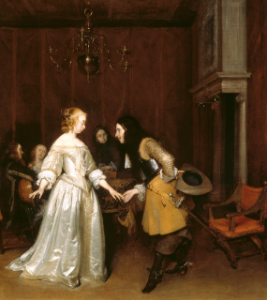Prized Possessions: Dutch paintings from National Trust Houses at the Mauritshuis: a missed opportunity?

Before Christmas I went to the exhibition of Prized Possessions: Dutch paintings from National Trust Houses on view at the Mauritshuis (October 2018-6 January 2019), This was a somewhat abbreviated version of the exhibition at the Holborne Museum, Bath earlier this year and has been reincarnated at Petworth at the end of January (26 January until 24 March 2019). For me it was a light bulb moment. With such a subject, it seemed such a lost opportunity.
The exhibition itself was fine, with some lovely works of art to admire but the focus was on the individual painting or artist. However, it did not give us very much about why particular paintings were collected at any time or why the owners wished to collect these works of art (the basic facts were given but no more) Was it a period taste? Or a fashion that meant newly wealthy needed to include these artists in their collections? Why particular types of Dutch artists rather than others? We understood that during the seventeenth century, as there were no English artists of merit, patrons chose to commission portraits from the Netherlands. We also were told that there were more Cuyps in Britain than even in Holland, and a beautiful Cuyp landscape from Ascott House, A View of Doordrecht, perfectly shows what the eighteenth-century English collector so admired. The fact that the paintings were shown by house, in no determined order undermined any historical understanding of the types of paintings admired in different periods or the reasons why.
Instead, the focus in the Hague was on the paintings themselves- a rediscovered Rembrandt for example- or the National Trust and its houses, as seen in the accompanying films. These were possibly created for a Dutch audience or perhaps just any audience with little knowledge?
In the full catalogue, published in English there is one essay that explores the history of Dutch paintings in Britain. So why was so little done to show the history of collecting? Is it just too difficult to display?
It is not that the exhibition was unattractive. It was lovely and many of the paintings shown were remarkable. Nor am I complaining (too much) about certain inaccuracies or the National Trust hype in the films on its gardens and tearooms, but the display could have invited the viewer to think as much about the collector as the painting and this it really did not do. Should it have? Or is this just the point of view of a hardened historian of collecting? But I would have loved to know more about how and why Captain Baillie bought the Cuyp and how it was sold to George Colebrook; why it was still in fashion- or was it? In the nineteenth century it was bought by Holford and then Anthony Rothschild. Did they regard it in the same way? What was the price then?
With the number of exhibitions devoted to collections or to individual collectors on view at the moment, maybe this is a good time to consider how the history of collecting can be displayed in exhibitions? What are the problems? The fact that the exhibition will be on display at Petworth (end of January to end of March) gives us a chance to think, compare and comment.
There are further exhibitions on collecting we can think about: Lost Treasures of Strawberry Hill: Masterpieces from Horace Walpole’s Collection 20 October, 2018- 24 February 2019) and the Campana Collection in Paris (A Dream of Italy: The Marquis Campana’s Collection from November 7, 2018 to February 8, 2019. And what about the exhibition Sold at the Bowes Museum, looking a the role of the dealer? Let’s look at these and see what methods they use to get across these complex questions? Do they help todays’ audience appreciate not just the objects on display but also perhaps why someone or some people might have wished to own these works of art- and if so how?
Adriana Turpin 18 January, 2019
